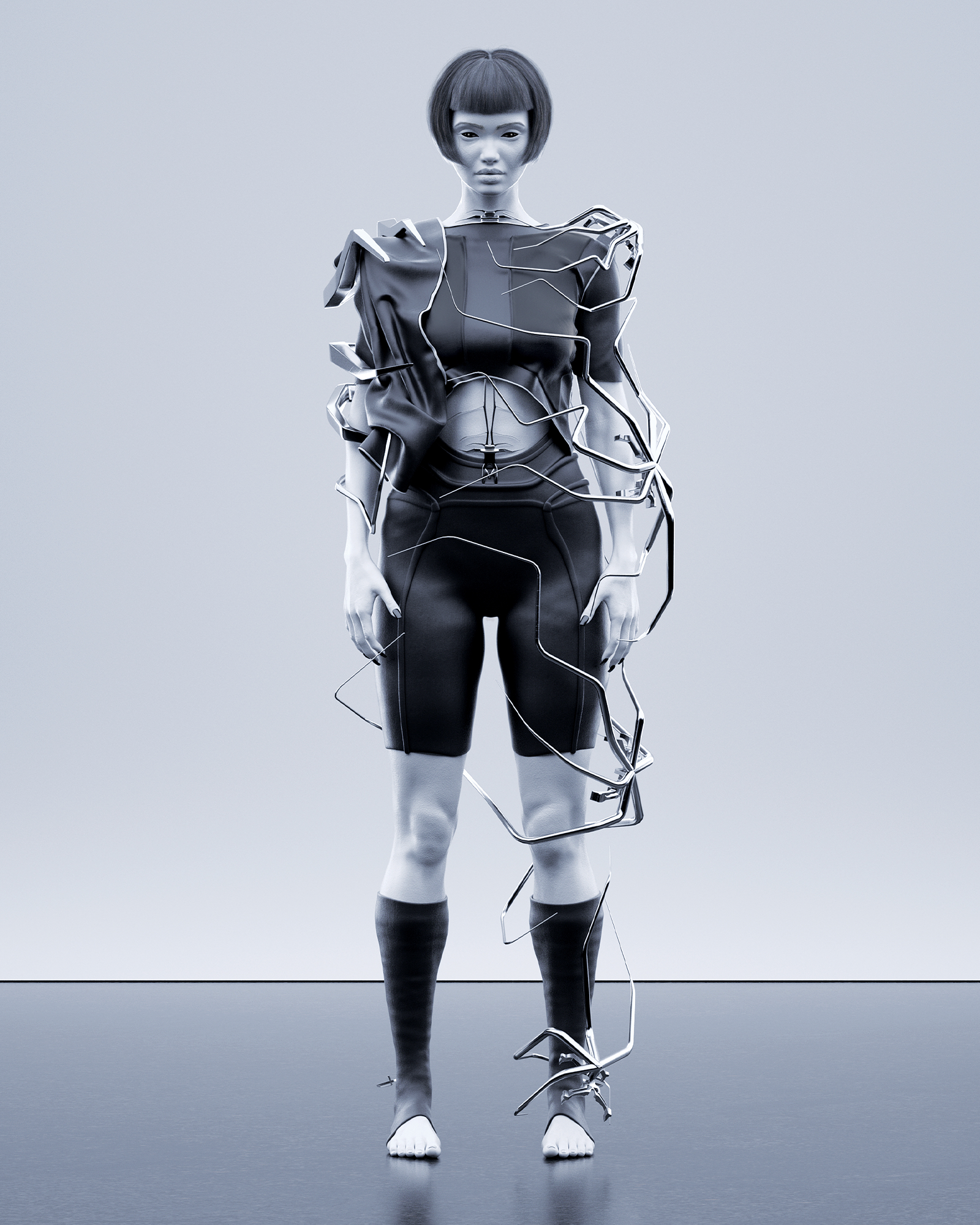Isodope is the digitally created alter ego of Brazilian model Isabelle Boemeke. In an aesthetic merged between solarpunk and vaporwave Isodope is described as an alien-like, fission-powered creature. But as the World’s first ever nuclear energy influencer she has a more earthly mission, to decarbonize the planet.
There’s no doubt that nuclear gets a bad rep, but futurists and scientists are pushing back, shining a light on just how important the energy source is for our climate targets and more importantly our species as we evolve into the future. Isabelle as Isodope is attempting and succeeding at making this message accessible to all, atomic reactions and the difference between fission and fusion would have the average person scrolling past in a second, but Isodope is managing to not only capture attention with TikTok style videos, but explain the fundamentals in exciting and digestible ways.
If ever there was an influencer that the world needs, Isodope is it. For our Earth 2070 cover feature we teamed up with photographer/artist Shxpir and Isodope to show the stark outcomes between us as a species not acting on the clean energy available to us. 2070 will either be a dystopia or utopia, the choice is ours.
What was the specific catalyst for you founding Isodope?
The first time I paid attention to nuclear power was in 2015, when Nasa scientist Carolyn Porco tweeted about “molten salt thorium reactors”. It piqued my curiosity back then, but I only channeled that curiosity into action in 2019. The fires in Australia and the Amazon were a wake up call to me, climate change is here, now. It is no longer an abstract problem for future generations, it’s up to us to face and solve it. After reading about what it would take to do so, I came across nuclear energy again. The science on nuclear power is clear: it’s clean, nuclear power plants make electricity without emissions. It's one of the safest forms of energy production, even accounting for the accidents. It’s one of only two technologies with a track record of successfully decarbonizing grids, the other technology being hydro. But of course there is a tiny problem, most people hate or fear nuclear power. I noticed this bizarre disconnect between reality and public perception and saw an opportunity to deliver the facts about nuclear energy in a unique way that tapped into my creative skills. As a fashion model with a social media presence, I knew the best way to deliver that information was through creating content that people already gravitate towards, like makeup tutorials and workout tips. I also decided to create a character that was eye-catching and intriguing and so Isodope was born: an almost alien-like, fission-powered creature who uses memes and humor to deliver the truth about nuclear power.
Why do you feel Nuclear Fission (instead of Fusion) is so important for the human race as an energy source?
We find ourselves in a dilemma, we need energy to maintain our civilization but, if we keep getting it from the same sources we will cause potentially irreversible damage to our planet, ourselves and other species. We must stop adding these planet warming gases to the atmosphere. The good news is that we know how to do that! One of the most important things is to make sure we get ALL of our electricity from sources that do not emit CO2 and methane, sources like wind, solar, hydro, nuclear and geothermal.
Nuclear power is a proven technology that has been successful at decarbonizing grids as best exemplified by France. In the 1970’s during the oil crisis, France decided to become energy independent. They built 48 reactors in 18 years and drastically reduced their reliance on fossil fuels for electricity generation. Today France's carbon emissions per kWh are lower than Germany, the UK and Denmark. The country also has some of the cheapest electricity in Europe.
Nuclear fission (splitting atoms to create energy) is already here, works at large scale and can help us decarbonize today! Nuclear Fusion (smashing atoms together) on the other hand is in its infancy and we still haven’t been able to get more energy out than we put in. I am all for continuing investing in and developing the technology, as we will need energy for as long as our species is around. However, I am not counting on fusion to contribute to any meaningful decarbonization within the next decades.
The USA under President Joe Biden is aiming to achieve net zero emissions by 2050, stating solar will provide 40% of this, how does nuclear fit into this goal?
Nuclear currently provides 20% of the US’ electricity, unfortunately we are shutting down perfectly fine nuclear power plants, which is decreasing that percentage. Solar currently provides around 2.3% of the US’ electricity for comparison. Solar is great, however it is intermittent, when the sun is not shining you can’t make electricity. Batteries solve some of that problem, but not all. We need long term storage that can handle weeks and sometimes months without being recharged. In order to ensure we have zero carbon electricity at all times we need what is called “firm power” like geothermal or nuclear and sometimes hydro. Firm power means these sources can generate electricity 24/7, independently of the weather. Geothermal and hydro are geographically dependent, whereas nuclear can be built pretty much anywhere. I see nuclear serving as a baseload or even adjusting its output to support variable renewables like wind or solar when these are not available.
One of the craziest things you’ve mentioned is that a natural nuclear reactor existed hundreds of thousands of years before humans did, can you tell us about it?
Two billion years ago Gabon, a country in Africa, was home to the only known natural nuclear reactor in the world: Oklo! Scientists discovered this after being puzzled by the fact that the Uranium from that region had lower concentrations of U-235, the fissile isotope in Uranium. After some investigation they discovered that billions of years ago the uranium caves in the region had just the right conditions which allowed chain reactions to take place. When it rained, rain water would pool around the uranium in the cave and serve as a moderator. Oklo sustained chain reactions for hundreds of thousands of years. I love this fun fact because nuclear power seems like an alien technology, but in reality it appeared in nature, long before humans were around. It also tells us what happens to nuclear waste and proves that it can be safely disposed of when placed deep in stable rocks.
The biggest argument against nuclear power is the waste it produces, often claimed that the waste stays radioactive for thousands of years. What is the truth behind nuclear waste?
I sympathize with that argument. Highly radioactive waste that stays that way for thousands of years sounds really bad. If I could wave a magic wand and make nuclear waste disappear, I would. However, as with anything in life, you have to compare it to the alternatives. CO2 waste from fossil fuel plants is not regulated at all, it spews in our atmosphere creating air pollution and causing climate change. Nuclear is the only energy generating industry that is responsible for disposing of its waste. The waste people fear is called “spent fuel”, the ceramic uranium pellets that are used in power plants to make electricity. When these pellets come out of the reactor they are very radioactive and literally hot, so they are placed in a pool for a few years to cool down. After it has cooled down enough, it is put inside big concrete casks, which block the radiation. Concrete is so effective at blocking radiation that you can stand right next to one of these casks containing the spent fuel safely. The waste is also very small, for example if I were to get all my life’s energy from nuclear, the amount of spent fuel I would leave behind would fit inside of a soda can. Spent fuel is also over 90% reusable uranium, which can be recycled and used to create more electricity, countries like France already do that. However, even after recycling we are left with a small amount of radioactive waste that needs to be disposed of. That’s when our knowledge of Oklo, the natural nuclear reactor in Africa, comes in handy. We know that the best and safest way to dispose of those radioactive elements is to put them deep underground, far from water sources and in highly stable geological formations. In the Netherlands the nuclear waste facility also doubles as a museum, you can tour it and look at some beautiful art right next to waste casks. Finland is building the world’s first commercial deep geological repository where they intend to dispose of their high level radioactive waste forever. So when people say we don’t have a solution to nuclear waste, they are wrong. We have technological solutions, we just need to implement them.
Solar and wind have a completely different reputation to nuclear, as if they have no waste at all, how do they compare to nuclear power environmentally?
Solar and wind are more appealing because they have been framed as natural. But, as is the case with any technology we create, they have downsides. There are environmental impacts associated with mining rare earths and critical metals necessary to make solar panels and wind turbines, just like there are environmental impacts associated with mining uranium to produce nuclear power. We also lack regulations around the proper and safe disposal of panels and turbines when they reach the end of their lives, after about twenty years. All that said, I find it complicated and uninteresting to compare renewables and nuclear waste, since in my opinion they are all imperfect technologies, but certainly better than what we currently use.
We have to stop letting the perfect be the enemy of the good. Progress is incremental and renewables and nuclear, although imperfect, are orders of magnitude better than fossil fuels.
What do you feel the solution to solving these reputation biases is, how can nuclear become more popular?
The world was introduced to the word nuclear through the bombing of Hiroshima and Nagasaki. Even though nuclear energy and nuclear weapons serve opposite purposes, they share similar physics and the name. Those who witnessed the destruction caused by nuclear weapons, obviously have a very strong negative association with the word and have transferred it on to nuclear energy. I am skeptical that older generations can change their minds and embrace nuclear power. What gives me hope is that younger generations are able to look at the data with clear eyes untainted by bias. We already see a very clear divide between younger and older environmentalists, with the former supporting nuclear power.
I actually see a lot of parallels between nuclear and AI. Imagine if the world first learned about AI through it killing hundreds of thousands of people? Of course we would be terrified and very resistant to keep developing the technology, even if it could be used to dramatically improve people’s lives and the world. Some technologies we create are what Nick Bostrom calls gray balls, they have the potential to be both incredibly productive or utterly destructive. This is where human agency comes in, we get to choose carefully how we want to implement these extremely powerful tools. In the case of nuclear fission, the knowledge of how to make bombs already exists and is distributed, there is no way to reverse that. Even if we shutdown every single nuclear power plant on Earth, nuclear weapons and the knowledge of how to make them would still exist. The best we can do is push for better regulations that ensure we can only use the technology for peaceful and life promoting purposes.
It’s helpful if those who support the technology voice their opinion, since that signals to others that it’s ok to do so. Besides bringing nuclear power into the conversation around climate change, one of the most important things folks can do is get engaged locally and work on saving existing nuclear power plants from being prematurely shutdown. For example, in my state of California I am fighting to save Diablo Canyon, the state’s last nuclear power plant, from being closed. This plant alone creates carbon-free electricity for 3 million people and its output will most likely be replaced by fossil fuels. The same is happening around the world, but if enough people fight for it, they can prevent these early closures.
Let’s talk Terrapower, the nuclear fission start up by Bill Gates, they’re aiming to power their reactors with nuclear waste, how is that possible, and is this the next stage of nuclear advancement?
Breeder reactors can literally run off of nuclear waste by recycling it and that’s how most historical national nuclear energy programs envision their progression. If we were to build a lot of these reactors, there’s enough energy in the current spent fuel to power the whole USA for around 100 years. Terrapower however, isn’t working on a traditional breeder reactor. They are working on a related technology called Natrium, a high temperature reactor that’s plugged into a thermal energy storage system, which allows it to integrate really well with variable renewables like wind and solar. More traditional nuclear reactors can turn their output up or down to accommodate renewables as well, but it’s not economically attractive. By having the plant connected to a thermal energy storage system the Natrium would bypass these issues. The plant would charge the storage system when solar and wind are producing a lot of electricity and have both the reactor and storage provide electricity at night or when the wind is not blowing.
The other cool thing about Terrapower is that they’re building their first reactor near a retiring coal plant in Wyoming. They can utilize the existing transmission lines and some of the infrastructure and retrain the workforce, who would otherwise simply lose their jobs when the coal plant retired.
Thorium seems to be the word on everyone's lips for nuclear, it’s more abundant on Earth, it doesn’t need enrichment like Uranium, how does Thorium fit into the future of nuclear?
There is a saying in the nuclear community that people come for the Thorium and stay for the LWR [light water reactor, a more traditional design of nuclear reactors]. I was one of those! Thorium sounds like a miracle and the truth, as always, is that it’s a little more complicated than that. It is more abundant than uranium on the Earth’s crust and we can absolutely use it as fuel. In fact, Thorium was used in one of the reactors at the late Indian Point Power Plant in NY, however it was more expensive than using Uranium so they switched it to the latter. Thorium doesn’t need enrichment, but that is because it’s not fissile so you still have to mix it with U-235 in order to start a chain reaction. Therefore it does require enrichment. There are some claims that Thorium cannot be used to make bombs, but that is a half truth, it only requires one extra step. If a bad agent is very committed to creating a bomb with Thorium, they can. I think Thorium can be used in parallel with Uranium, but I don’t see it becoming the only fuel for nuclear power plants.
Who are you excited about that is creating the future for nuclear, in essence who is on your radar?
In countries like the United States, building traditional reactors has proven difficult recently. These are massive projects that end up being delayed and over budget, so several startups are trying to develop smaller and modular reactors that can be standardized. Companies like Oklo, who are building modular micro-reactors [1.5 MW] that can be used to replace diesel generators in remote areas. Terrapower, who are designing a high temperature reactor plugged into a thermal energy storage, which pairs really well with renewables. Terrestrial Energy are building a molten salt modular reactor that also pairs well with renewables. Terrapower and Terrestrial Energy reactors also create high grade heat, which can be used for industrial applications. These are just a few of the many new nuclear energy companies that are trying to build advanced reactors that are smaller, standardized and hopefully cheaper. Countries like Korea, Russia and China have had more success building traditional reactors on time and on budget. They are now building those all over the world. For example, Korean KEPCO has built one 1,400 MW unit in the United Arab Emirates, with three more being built.
Let’s go really big picture for a minute, if we look at the Kardashev Scale do you see nuclear power as part of us becoming a Type 1 and Type 2 civilization or a boot loader for advanced energy sources like antimatter, fusion and even one day a Dyson sphere?
It seems like nuclear is fundamental for us becoming a Type 1 civilization and it is a great source of energy until we develop even better ones like fusion and a Dyson sphere. Interestingly, nuclear power will also be necessary if we are to ever colonize Mars. It would be very difficult to send, install and maintain the amount of solar panels necessary even just to generate enough fuel for return journeys, let alone maintain a base. Wind doesn’t work on Mars and geothermal is a big question mark.
How do you feel about nuclear fusion, could it really be our species’ saviour, or will it be too late by the time we master it?
I am not counting on fusion to help us decarbonize in the near future and prevent the worst impacts of climate change. However, it could be another incredible source of clean energy our species has at its disposal. Humans are constantly finding new ways to use energy and as we move towards an increasingly digital world, which will include extremely energy intensive technologies like quantum computers, the more clean energy we can have the better. Even though the technology is not fully there and there is uncertainty about whether it will ever be financially attractive, we are only constrained by our ability to imagine and the laws of physics. So, while fusion seems like a distant dream and might not play a role in the next decades, it’s still a feasible technology that’s worth pursuing.
As a species, what is the most important take-away we need to have about nuclear power?
No technology is perfect, there will always be a downside or some unintended consequence. However, we can improve upon them incrementally. Nuclear fission is just one of the many gray balls, technologies with incredible potential for both creation and destruction, our species stumbles upon or creates. We need to become wiser and learn from our past mistakes, develop better regulations and ensure we always use them for improving human lives, our society and planet.
On our current trajectory, to you, what does Earth 2070 look like?
The future of our planet and species literally depends on our actions right now. Not to get too philosophical and woo woo, but whichever future we choose to dream of will ultimately be the future we build, since our current and future actions will be aligned with that vision. The world seems impossibly complex and at times it feels like our individual efforts might be futile. However, when you boil it down to its essence, society is nothing more than a bunch of people interacting with one another and the environment around us. No other species on Earth has the ability to transform the universe like we do. We all have the power to choose the future we want and create the conditions necessary to make that future a reality.



